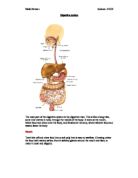(See diagram).
What is mechanical digestion?
Mechanical digestion takes place in the mouth via chewing the food to make it easier to swallow for the stomach to then pummel up the food with its muscular walls. All the way along the alimentary canal there is a muscular tissue, which squeezes the food along, the action is known as peristalsis.
What is chemical digestion?
Chemical digestion is a break down of big molecule to small molecules via the use of enzymes. Starch proteins and fats are big molecules, which cannot pass through cell walls into the blood. Sugars, amino acids and fatty acid/ glycerol are much smaller molecules, which can pass easily in to the blood. Enzymes act as catalysts to break down the big molecules into smaller ones.
Carbohdrase is produced in three different places:
The salivary glands, the pancreas and the small intestines. This converts starch into simple sugars like glucose or maltose etc.
Protease is produced in three different places:
The stomach, the pancreas and the small intestine. This converts proteins into amino acids.
Lipase is produced in two different places:
The pancreas and the small intestine. This converts fats into fatty acids and glycerol.
Bile is produced in the liver to neutralise the stomach acid and emulsifies fats.
List and briefly describe at least 8 functions of the liver.
- Production of bile.
- Deamination of surplus amino acids.
- Regulation of blood sugar by interconversion of glucose and glycogen.
- Storage of iron, and vitamins A and D.
- Detoxification of poisonous by-products.
- Release and distribution of heat produced by the chemical activity of the liver.
- Conversion of the stored fat for the use by the tissues.
- Manufacture of fibrinogen.
List 6 or more activities of the stomach and what they do.
The internal lining of the stomach is called the gastric mucosa. The gastric mucosa contains long tubular gastric glands that secrete the gastric juices used in digestion. The gastric glands have 3 different substances. The parietal cells secrete hydrochloric acid, the chief cells secrete pepsinogen and the mucous neck cells secrete mucin.
Hydrochloric acid causes the acidity of gastric juice to be in the range of pH 1 to pH 3. This practically guarantees that any bacterium, which enters with food, is destroyed. Hydrochloric acid combines with pepsinogen to form the enzyme called pepsin. Pepsin digests only protein. Mucin is a secretion which protects the stomach from being dissolved by hydrochloric acid.
Describe the link between the digestive system and conditions such as asthma, migraine and uticaria.
Regarding the mucous, which is produced by the digestive system, too much can accumulate around the bronchioles and cause a constriction of your breathing, which leads to asthma.
Allergic conditions in the digestive system which produce inflammation in the intestinal tract can be the cause of a migraine because it can affect the blood and nerve activity.
Urticaria is a condition in which red, itchy and swollen areas appear on the skin. Usually as an allergic reaction from eating certain foods or taking certain medicines.
Name 3 conditions effecting digestion. What help can an aromatherapist offer in regard to helping these conditions?
Bergamot stimulates the production of gastric juices, tone the stomach and aids digestion. Therefore it is good for dyspepsia.
Bergamot also relaxes the muscles of the digestive tract and can relieve constipation.
Rosemary stimulates the production of gastric juices and bile therefore it can be used to treat liver infections.
Bibliography
CGP GCSE Double Science Biology. The revision guide.
Collin GEM biology Basic facts
The family medical reference book
British medical association family doctor home advisor
Aromatherapy and natural health







